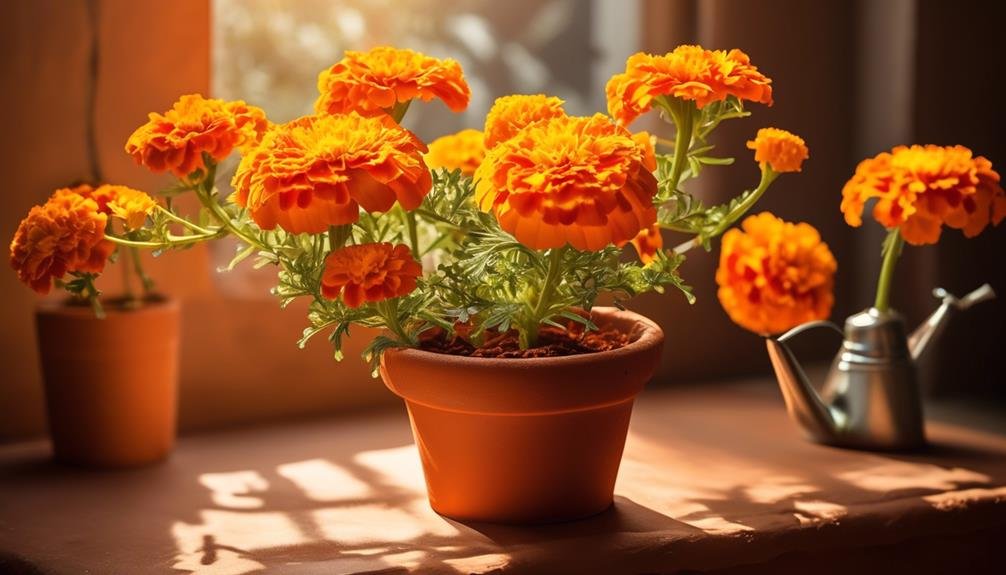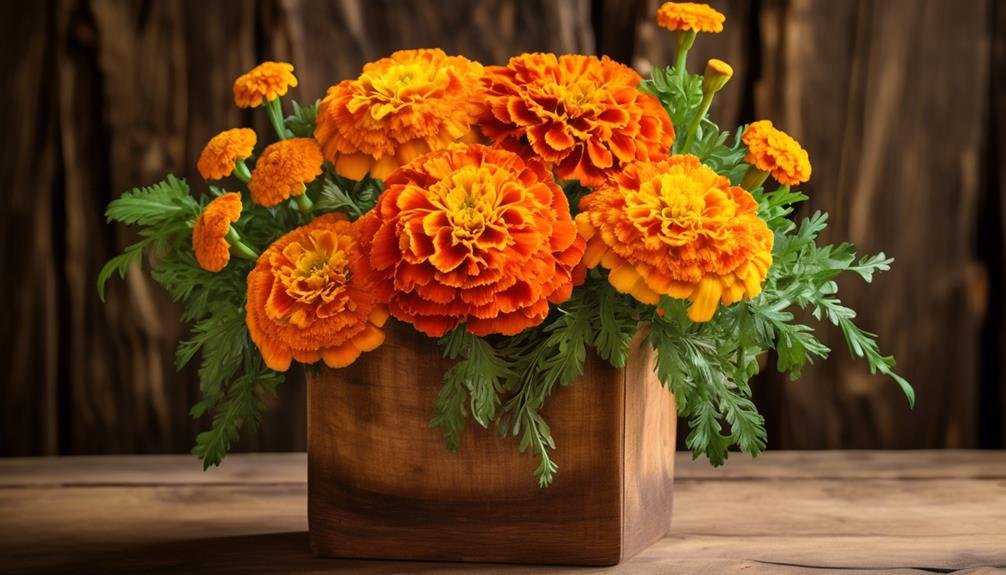Popular Types of Florist Flowers – Marigold
Marigolds are a popular choice for florists due to their vibrant hues and wide range of varieties. From the bold orange tones of Hero Orange Marigold to the delicate petals of Alumia Vanilla Cream Marigold, there is a marigold to suit every taste.
In addition to their beauty, marigolds have scientific intricacies, historical significance, and practical care tips that make them a fascinating subject to explore. Let's delve into the world of marigolds and uncover the secrets behind these beloved blooms.
Scientific Name
Marigold Scientific Names and Their Significance in Horticulture
Scientific nomenclature plays a crucial role in identifying and categorizing marigold species. The scientific names, such as Tagetes erecta (African marigold), Tagetes patula (French marigold), and Tagetes tenuifolia (Signet marigold), are essential for accurate communication and understanding of the diverse marigold species.
Benefits of Growing Marigolds
Understanding the specific scientific names can help in selecting the most suitable species for particular gardening needs. For example, Tagetes erecta, known as African marigold, features tall, sturdy plants with large, showy flowers in various colors, making it a popular choice for vibrant garden displays. On the other hand, Tagetes patula, or French marigold, with its compact size and dainty flowers, is ideal for edging, borders, and container plantings.
Importance in Horticulture
Knowing the scientific names of marigolds facilitates accurate classification, ensuring that the right species is cultivated in the appropriate conditions. This knowledge helps in providing specific care and environmental requirements for each type of marigold, ultimately leading to successful cultivation and optimal growth.
Background History
Marigolds have a rich history deeply intertwined with diverse cultural traditions and ceremonies, making them a beloved flower with deep-rooted symbolism and practical uses. Their healing properties have been utilized in traditional medicine for centuries, treating various ailments such as skin conditions and digestive issues. In addition to their medicinal uses, marigolds have spiritual significance and have been used in ceremonial practices to promote wellness and healing.
These vibrant flowers have been integral to numerous cultural traditions and ceremonies, symbolizing remembrance and vitality. Their vibrant colors, ranging from yellow to orange, have made them a prevalent feature in cultural celebrations, including weddings, festivals, and religious ceremonies. Marigolds have been employed in offerings to guide spirits and brighten gardens, adding a touch of joy, optimism, and positive energy to horticultural settings.
Their non-invasive and non-aggressive nature has made marigolds a favorite among gardeners, as they add vibrant colors from summer to the first frost, making them a favored choice for ornamental purposes. With their enduring history and cultural significance, marigolds continue to maintain a significant presence in both horticulture and cultural practices.
Physical Description

Marigolds are a fascinating botanical specimen with a wide array of colors and varying sizes. Their vibrant shades range from orange, yellow, red to bicolored pastel pink, rose, and yellow. The flowers come in different sizes, from enormous, brilliant blooms to small, single flowers in shades of gold, orange, lemon, or paprika. Marigolds can have a compact, bushy appearance or be tall and robust, with some varieties featuring delicate, refined appearances and others densely branched with large, double orange blooms. The foliage of marigolds varies from grey-green, strongly fragrant leaves to mounds of lacy, citrus-scented, or finely divided foliage. This diverse array of physical characteristics makes marigolds an intriguing botanical specimen.
In traditional medicine, marigolds have been used for their healing properties. Their flowers and leaves are believed to possess medicinal qualities and have been used to treat various ailments. Additionally, marigolds hold significant cultural and symbolic value in different societies. They're often associated with celebrations, rituals, and religious ceremonies, symbolizing positivity, joy, and good fortune.
The physical diversity of marigolds, coupled with their uses in traditional medicine and symbolism in various cultures, underscores their importance as a versatile and culturally significant floral species.
Colours and Characteristics
Marigolds, with their vibrant colors and unique characteristics, are a fascinating subject to explore in the context of gardens, floral arrangements, cultural significance, and traditional medicine. These flowers come in a variety of colors such as orange, yellow, red, and cream, adding a lively touch to gardens and floral displays. Different marigold varieties showcase distinct features, from large double blooms in Hero Orange Marigolds to compact, bushy growth in Yellow Jacket Marigolds.
In terms of colors, marigolds exhibit a wide range, from rich mahogany-orange with yellow tips in Safari Scarlet Marigolds to bicolour pastel pink, rose, and yellow in Strawberry Blonde Marigolds. The Signet Marigolds, on the other hand, are known for their delicate appearance and vibrant paprika, pumpkin orange, and lemon yellow blooms. These flowers also emit a citrus scent, adding to their allure.
Culturally, marigolds hold significance in various cultures, with Mexican Marigolds being used in offerings and traditional medicine. They're valued for their range of yellow to orange colors, brightening up gardens and symbolizing positive emotions and events in different cultures. In traditional medicine, marigolds are recognized for their anti-inflammatory and healing properties, as well as their ability to soothe digestive issues and promote healthy skin.
Varieties Available

Marigolds come in a variety of types and colors, offering a diverse range of options for gardening and decorative purposes. Some popular varieties include Hero Orange Marigold, Yellow Jacket Marigold, Pot Marigold, Zenith Red Marigold, and Tiger Eyes Marigold. These varieties come in bright orange, yellow, golden yellow, red and gold, and yellow with red stripes, respectively.
Marigolds are adaptable plants that thrive in various climates, from temperate to subtropical regions, with minimal maintenance required.
Additionally, marigolds hold cultural significance in different countries and are often used in religious ceremonies, festivals, and traditional practices. For example, in Mexico, marigolds are an integral part of the Day of the Dead celebration, symbolizing the fragility of life.
Seasonal Availability
Marigolds are typically available from late spring to early fall, with peak abundance during the warmer summer months. However, climate change can impact their availability by altering blooming seasons. Warmer temperatures may extend the blooming period in some areas, while unpredictable weather patterns can disrupt growth in others.
Marigold availability also varies by region, with warmer climates seeing longer availability and colder climates limiting availability to the peak summer season. Local climate and growing conditions play a significant role, with warmer temperatures and ample sunlight promoting robust growth and blooming.
Understanding seasonal availability is crucial for florists and enthusiasts to plan and utilize these vibrant flowers effectively in various floral arrangements and decorations.
Care Tips

Marigold Care Tips for Optimal Growth and Blooming
- Soil and Watering:
- Plant marigolds in well-draining soil to prevent root rot.
- Water regularly to keep the soil evenly moist, but avoid overwatering to prevent fungal diseases.
- Climate-specific Care:
- In warmer climates, ensure marigolds receive adequate water and protection from intense heat to prevent wilting.
- In colder climates, provide a layer of mulch to insulate the soil and protect the roots from frost damage.
- Sunlight and Deadheading:
- Marigolds thrive in full sun or partial shade for optimal growth and flowering.
- Deadhead regularly to remove spent flower heads, stimulate further blooming, and prevent excessive self-seeding.
What Are the Best Ways to Care for Marigold and Snapdragon Flowers?
When caring for different types of florist flowers like marigold and snapdragon, it’s important to provide adequate sunlight, water, and well-drained soil. Regular pruning and deadheading can also help them thrive. Marigolds benefit from pinching off spent blooms, while snapdragons do well with regular watering and fertilizing.
Conclusion
Marigolds, scientifically known as Tagetes, are a popular choice for florists because of their vibrant colors and long-lasting blooms. They come in a wide variety of options, from Hero Orange to Mexican Marigold, catering to every preference.
Marigolds are available throughout the seasons and are easy to care for, making them a versatile and attractive option for decorative use in gardens, planters, and hanging baskets.






